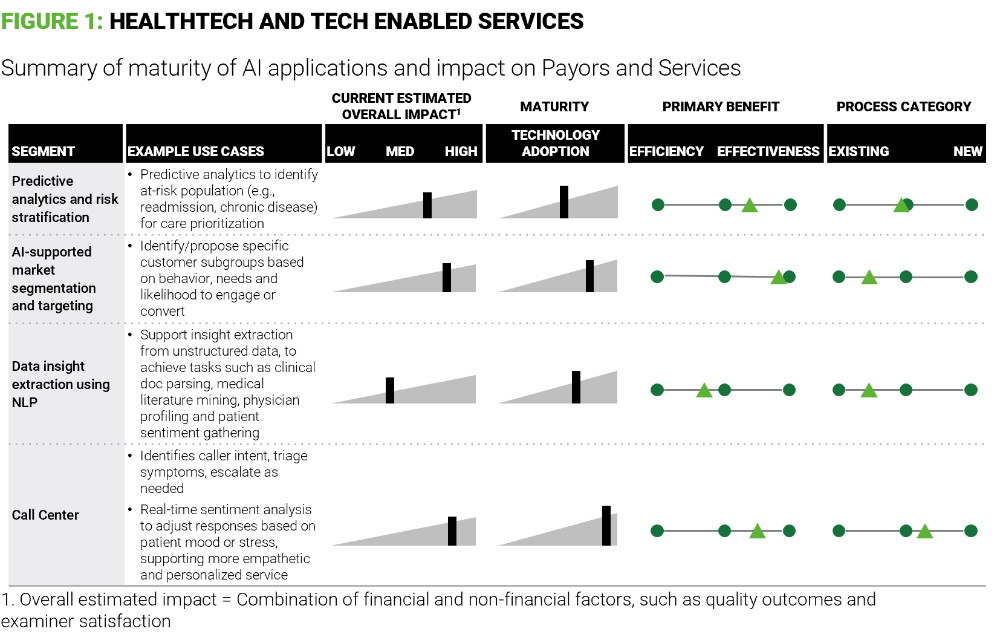- within Food, Drugs, Healthcare and Life Sciences topic(s)
- in Turkey
- within Antitrust/Competition Law, Intellectual Property and Real Estate and Construction topic(s)
- with readers working within the Retail & Leisure industries
Private equity's investments in healthcare have often struggled to meet expectations. Top-line growth and attractive exit multiples are elusive in a sector weighed down by legacy systems, labor costs, and regulatory complexity. The urgent question facing investors, operating partners, and portfolio company leaders is: How can we reinvigorate returns and unlock enterprise value?
In this article, we will explore how AI is already making an impact in specific use cases in HealthTech and tech-enabled services.
The AI moment for HealthTech
Our data show a clear gap in HealthTech company performance, especially for the PE owned mature mid-tier ones: despite double-digit revenue growth in HealthTech (26.7%) over the past 3 years, EBITDA margins lag well behind other industry segments. For most mid-tier PE owned mature HealthTech companies, cost pressures are swallowing top-line gains, and operational complexity prevents meaningful margin expansion.
Exhibit 1: Financial performance of healthcare segments
| Segment | Revenue Growth % | EBITDA Margin % |
| HealthTech | 26.7% | 2.7% |
| Providers | 9.5% | 1.9% |
| Insurance | 13.7% | 6.8% |
| Payers | 18.8% | 15.0% |
HealthTech companies lead in revenue growth but lag in margin expansion, highlighting the need for AI-enabled operational improvement.
However, AI is emerging as the game-changer. HealthTech platforms are now deploying generative AI and advanced analytics to address operational inefficiencies, improve engagement, and unlock new areas of growth.
AI isn't all hype—it's already driving higher retention and utilization. One platform recently reached a 70% engagement and retention rate, showing real-world benefit in patient interactions.
Why PE should prioritize AI in healthcare today
PE investors have long sought growth levers that both expand margins and drive topline growth. For example, AI-powered tools automate administrative tasks, reducing clinician after-call work by over 50%, freeing up time for higher-value activities. The new wave of AI adoption offers the possibility of:
- Predictive analytics and risk stratification:
Risk detection models enable targeted outreach for early
intervention, improving outcomes and reducing costs. For example:
- i) Early identification of high-risk individuals enables timely intervention and care pathway optimization,
- (ii) Minimize preventable hospitalizations, ER visits, and readmissions through proactive care,
- (iii) Tailor interventions to patient-specific risk factors instead of one-size-fits-all protocols,
- (iv) Focuses clinical resources where they create maximum impact, improving population-level health metrics
- AI-supported market segmentation and
targeting: Customer subgroups can be identified based on
behaviors, needs, and engagement likelihoods. For example:
- (i) Segments populations based on behaviors, clinical history, care needs, and value potential,
- (ii) Personalized engagement strategies improve conversion and adherence to care pathways, etc.
- Data insight extraction using Natural Language
Processing (NLP): Unstructured data can now provide
insights on a broad range of clinical, customer, and operational
matters. Unified data platforms and retrieval-augmented generation
(RAG) AI tools speed reporting and operational decision-making,
driving accuracy and efficiency. For example:
- (i) Converts clinical notes, claims text, and care documents into actionable intelligence,
- (ii) Surfaces relevant information at point-of-care (symptoms, risk flags, research evidence), etc.
- Patient support: AI can conduct automated empathy detection and quality assurance in patient calls, promoting better engagement without expanding headcount.
These capabilities do more than save labor. They reposition portfolio companies for scalable, defensible growth and more attractive exit stories.

Specific AI use cases driving healthcare value
Within these segments, AlixPartners has a growing depth of experience working with HealthTech companies to apply AI tools to drive material value creation across their enterprises. For example, we worked with one recently acquired healthtech company that needed to reduce costs without hurting growth. By analyzing unit economics and deploying AI tools like voice assistants and intelligent routing, the company saved millions of dollars in its first 100 days.
For another client, we helped them build their AI engine by putting together the necessary infrastructure and data pieces to improve clinical productivity and deliver a potential operational cost efficiency of 40%. Here are the five levers we used:
- Data access and analytics:Unified lakehouse + RAG-based AI tools
AI-powered data platforms unify disparate healthcare data sources—claims, EHR, member interactions—into a single "lakehouse" architecture (i.e., a unified data architecture that combines the best features of a data warehouse and a data lake). Using retrieval-augmented generation (RAG), advanced AI algorithms deliver faster, more accurate insights for care delivery, quality reporting, and operational optimization. For example, a client replaced fragmented Excel-based analytics with an AI-driven dashboard, enabling real-time analysis of population health trends and cost drivers, accelerating decision-making and risk identification.
- Administrative efficiency:Auto-call summarization
Generative AI tools now automate post-visit or post-call note generation for clinicians. One client deployed an auto-summarization model that reduced after-call work by more than 50%. Clinicians could spend less time writing up notes and more time interacting with patients, resulting in increased throughput and higher reported satisfaction. Financially, this drove measurable improvements in labor utilization and margin expansion, especially for high-volume care navigation centers.
- Quality and empathy:Empathy detection in calls
Scalable quality assurance in member interactions is tough—manual call reviews miss nuance and are expensive. One platform leveraged AI to analyze voice tone, sentiment, and conversational context to identify empathy (or the lack thereof) in member calls. Automated flagging accelerated feedback for care advocates and improved member engagement, supporting documented NPS score gains and enabling more targeted training.
- Self-service:Virtual assistant (AVA) handling routine tasks
AI-driven virtual assistants like AVA handle routine member questions—about benefits, copays, coverage details, and common symptoms. In one deployment, more than 70% of activated members used the virtual assistant for most non-complex interactions, freeing human advocates to focus exclusively on complex or high-value cases. This improved engagement, delivered rapid response times, and surfaced actionable data on member pain points for product teams.
- Proactive care:Risk detection and targeted outreach
Predictive AI models flag at-risk members for preventive interventions—based on claims, clinical, and engagement data—enabling targeted outreach before major health events occur. One client's program reduced avoidable hospitalizations by double digits, as care managers proactively contacted flagged members and coordinated early, lower-cost interventions. These AI programs generate direct cost savings, improved outcomes, and substantial enterprise value lifts.
| Function | AI Use Case | Impact |
| Data Analytics | Unified lakehouse + RAG tools | Faster, more accurate insights |
| Administrative efficiency | Auto-call summarization | >50% reduction in clinician after-call work |
| Quality | Empathy detection in calls | Automated QA and member engagement |
| Self-Service | Virtual assistants | Seamless routine support; focus on complex |
| Proactive Care | Risk targeting and targeted outreach | Early intervention; reduced costs |
The value proposition: EBITDA expansion and attractive rollups
For PE, AI bridges the top-line growth and margin gap. Intelligent automation, predictive analytics, and optimally staffed workflows can drive both rapid EBITDA uplift and scalable operating models. HealthTech companies that embrace AI are more likely to:
- Accelerate margin expansion for rollup strategies
- Differentiate their platform during exit preparation
- Provide tangible operational improvement stories for buyers
The most successful PE-backed platforms will be those that master both the digital transformation and change management required to unlock AI's full potential. As more funds adopt structured playbooks to vet, deploy, and scale AI across their healthcare investments, the sector's reputation as a returns laggard could be left behind.
AI in healthcare is not a distant promise. The ability to drive real operational improvements, elevate EBITDA, and revitalize exit narratives is here today. Portfolio companies and operating partners who act now—with clear frameworks, cross-functional alignment, and a focus on rapid impact—will be those that win the next generation of healthcare value creation.
Over the next few weeks, we will share additional insights for both healthcare providers and payors & services—what are the challenges for these sectors and where are we seeing use cases making a meaningful impact. We also encourage you to read our AI Playbook for PE Operating Partners, which provides a practical framework for driving value in PortCos through AI.
The content of this article is intended to provide a general guide to the subject matter. Specialist advice should be sought about your specific circumstances.





